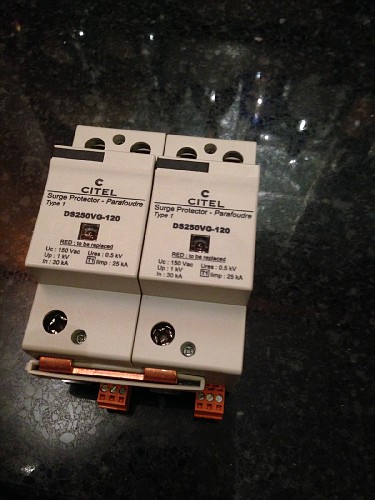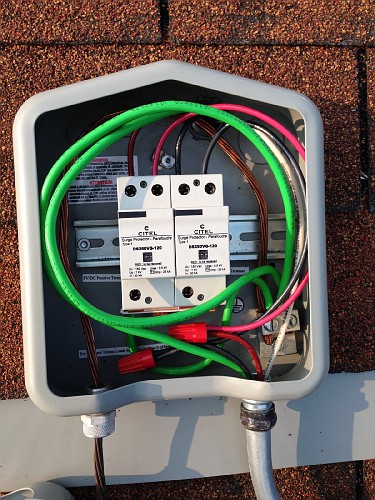I have a few times. Usually the skies are so dark, it's not producing anyhow. I worry about a surge in the grid taking out the Inverter. Am I too paranoid? 
Try our solar cost and savings calculator
anybody shutdown during electrical storms?
Collapse
X
-
-
Good question. I would GUESS that perhaps a bitt overly paranoid. My system has been up and running since the day they turned it on and that include some pretty good T-storms where the power went out for a couple of hours .. no ill effects. I would venture that since there are two cutoffs and one sizable breaker box between my inverters and the grid that chances of harm are slim to none -
I have seen systems shut down for storms. But I have no intention of baby sitting my system
for the rest of my life, so either it will survive, or it will fail & I will repair it.
I worry more about lightning strikes. There some 60 grounds to my panel frames & other
system components, but with lightning nothing is guaranteed. Bruce RoeComment
-
I've had one bad storm, where I got up at midnight, and pulled every breaker and cable that was accessible. Just give a near miss a route to your gear, and it's toast. The SPD's are for when you can't do anything about it.Powerfab top of pole PV mount (2) | Listeroid 6/1 w/st5 gen head | XW6048 inverter/chgr | Iota 48V/15A charger | Morningstar 60A MPPT | 48V, 800A NiFe Battery (in series)| 15, Evergreen 205w "12V" PV array on pole | Midnight ePanel | Grundfos 10 SO5-9 with 3 wire Franklin Electric motor (1/2hp 240V 1ph ) on a timer for 3 hr noontime run - Runs off PV ||
|| Midnight Classic 200 | 10, Evergreen 200w in a 160VOC array ||
|| VEC1093 12V Charger | Maha C401 aa/aaa Charger | SureSine | Sunsaver MPPT 15A
solar: http://tinyurl.com/LMR-Solar
gen: http://tinyurl.com/LMR-ListerComment
-
My install was a labor of love, and only 2 months old so I haven't gotten to the point of just ignoring it yet.I have seen systems shut down for storms. But I have no intention of baby sitting my system
for the rest of my life, so either it will survive, or it will fail & I will repair it.
I worry more about lightning strikes. There some 60 grounds to my panel frames & other
system components, but with lightning nothing is guaranteed. Bruce Roe A few seconds to shut it down, and a few minutes to restart, seems like a small price for a newbie that loves his solar!! lol
A few seconds to shut it down, and a few minutes to restart, seems like a small price for a newbie that loves his solar!! lol
Comment
-
Kind of like new girl friend vs old girl friend? [SIGPIC][/SIGPIC]
[SIGPIC][/SIGPIC]Comment
-
Comment
-
I agree with you. Nothing is guaranteed when it comes to a lightning strike.I have seen systems shut down for storms. But I have no intention of baby sitting my system
for the rest of my life, so either it will survive, or it will fail & I will repair it.
I worry more about lightning strikes. There some 60 grounds to my panel frames & other
system components, but with lightning nothing is guaranteed. Bruce Roe
My neighbor had the Utility install a surge protection device at his meter which is designed to keep power surges from lightning from getting into the house circuits through the main panel.
We had a storm last week that lightning hit close to his house on the side where the phone and cable service comes in. Needless to say he lost 2 TV's & cable boxes and one of his land line phones.
I love to watch those storms but you have to respect all that power.
Comment
-
In two close by strikes I have had lightning take out alarm panels (4) several home automation switch units - even fried one cable in the attic - like you said, fun to watch but very powerful. Since the system grounding has been redone - hope this guy knows his stuff![SIGPIC][/SIGPIC]Comment
-
They need to find a way to harness the power of lightning! Nothing is impossible, so somebody get on it!! We have 100's of HUGE wind turbines in my area. They could serve double duty as lightning rods!!
We have 100's of HUGE wind turbines in my area. They could serve double duty as lightning rods!!
Comment
-
Comment
-
Comment
-
I shut down all the time until I installed these SPDs:

The Citel DS52VG-120s also have a built-in spark gap/thermal fuse so they're pretty easy to install. Also, when I put up my array, I used a soladeck roof mounted junction box that had a DIN rail so that I could do SPDs:

Here they are installed:

Since I use micro inverters, the only side that needs protection is the AC side. I'm on the fence as to whether I should be protecting the neutral bus as well or not. The neutral side SPDs are extremely hard to locate and also need a GEC to stakes driven in close to the array itself. Neutral/ground side potential differences are usually caused by (very) close strikes and the risk level here in WI just isn't that high.
Still todo: install low voltage remote status LEDs. I'll wait till the attic cools off a bit in winter before I run that wire. You can see the connectors at the bottom of each surge protector. The Citel devices have a DPST switch that flips if the fuse blows.4KW system featuring Suniva OPT265/Enphase M215Comment
-
Lightening is not your friend
We get some nasty lightening storms roll through our area. I got hit, before solar, that blew 2 GFI's right out of the boxes in my bathroom. I am totally aware of the power of a gigawatt jolt. When putting in the solar system I installed a Midnight AC MOV unit on the main panel, a Midnight DC MOV on the combiner box output plus 2 8' ground rods at the main panel and a 8' ground rod at the array. But I still separate if I see those storms heading my way. I just don't want to go through the enormous hassle of removing my inverter to send to some shop 100's of miles away to get repaired. Plus it's a good excuse to exersize the AGM batteries. An ounce of prevention is worth a pound of cure!Ret. System Dispatcher PG&E San FranciscoComment
-
On the AC side, the most important protection is between the two hot leads and the neutral. Just bypassing the two hot leads to ground will likely cause a high difference between hot and neutral which will then damage your equipment.Since I use micro inverters, the only side that needs protection is the AC side. I'm on the fence as to whether I should be protecting the neutral bus as well or not. The neutral side SPDs are extremely hard to locate and also need a GEC to stakes driven in close to the array itself. Neutral/ground side potential differences are usually caused by (very) close strikes and the risk level here in WI just isn't that high.
Whole house SPDs are installed at the main service panel where the ground system and the neutral bus are connected solidly together, so there is no issue there.
But when you place the SPDs remotely, as you have, you need to make an informed decision as to whether to place the SPDs between hot and neutral, hot and local ground, or hot and EGC (green wire.) Or some combination. Spark gap devices are limited in effectiveness compared to MOV devices and are, I think, more usually associated with protection from static discharge or direct strikes.
Opinions differ on what is best for general surges and for close-by lightning strikes, so read up on it, especially the instructions that come from the SPD manufacturer.SunnyBoy 3000 US, 18 BP Solar 175B panels.Comment
Copyright © 2014 SolarReviews All rights reserved.
Powered by vBulletin® Version 6.1.3
Copyright © 2025 MH Sub I, LLC dba vBulletin. All rights reserved.
Copyright © 2025 MH Sub I, LLC dba vBulletin. All rights reserved.
All times are GMT-5. This page was generated at 04:56 AM.

Comment